Abstract
The aim of the present study was to verify whether strength training designed to improve explosive and maximal strength would influence rate of force development (RFD). Nine men participated in a 6-week knee extensors resistance training program and 9 matched subjects participated as controls. Throughout the training sessions, subjects were instructed to perform isometric knee extension as fast and forcefully as possible, achieving at least 90% maximal voluntary contraction as quickly as possible, hold it for 5 s, and relax. Fifteen seconds separated each repetition (6-10), and 2 min separated each set (3). Pre- and post-training measurements were maximal isometric knee extensor (MVC), RFD, and RFD relative to MVC (i.e., %MVC·s-1) in different time-epochs varying from 10 to 250 ms from the contraction onset. The MVC (Nm) increased by 19% (275.8 ± 64.9 vs. 329.8 ± 60.4, p < 0.001) after training. In addition, RFD (Nm·s-1) increased by 22-28% at time epochs up to 20 ms from the contraction onset (0-10 ms = 1679. 1 ± 597.1 vs. 2159.2 ± 475.2, p < 0.001; 0-20 ms = 1958.79 ± 640.3 vs. 2398.4 ± 479.6, p < 0. 01), with no changes verified in later time epochs. However, no training effects on RFD were found for the training group when RFD was normalized to MVC. No changes were found in the control group. In conclusion, very early and late RFD responded differently to a short period of resistance training for explosive and maximal strength. This time-specific RFD adaptation highlight that resistance training programs should consider the specific neuromuscular demands of each sport.
Key Points.
The time-specific RFD adaptation evoked by resistance training highlight that the method of analyzing RFD is essential for the interpretation of results.
Confirming previous data, maximal contractile RFD and maximal force can be differently influenced by resistance training. Thus, the resistance training programs should consider the specific neuromuscular demands of each sport.
In active non-strength trained individuals, a short-term resistance training program designed to increase both explosive and maximal strength seems to reduce the adaptive response (i.e. increased RFDMAX) evoked by training with an intended ballistic effort (i.e. high-RFD contraction).
Key words: Quadriceps, muscle adaptation, muscle strength, peak torque, power
Introduction
The rate of force development (RFD) is defined as the slope of the force-time curve obtained under isometric conditions (Aagaard et al., 2002). It has been used to evaluate the capacity to rapidly generate muscular force, which may be essential for sports performance (Aagaard et al., 2011) and functional tasks (e.g. locomotion and postural balance) (Aagaard et al., 2010). There is a positive association between RFD and maximal force (Mirkov et al., 2004), especially the RFD registered in the later phase (>100 ms relative to the contraction onset) of maximal voluntary contractions (MVC) (Andersen and Aagaard, 2006). Indeed, it has been demonstrated that RFD is influenced by different physiological parameters at early (<100ms) and late phase (>100ms) of the isometric contractions. The early phase is influenced by intrinsic muscle contractile properties (Andersen et al., 2010) and neural drive (Gruber et al., 2004), whereas the late phase is influenced by muscle cross- sectional area (Suetta et al., 2004), neural drive (Aagaard et al., 2002) and stiffness of tendon-aponeurosis complex (Bojsen-Møller et al., 2005).
Previous studies have reported substantial enhancements in knee extension (KE) RFD following different types of resistance training protocols such as traditional (i.e., machine-based and free weight exercise programs), explosive or isometric strength training (Kubo et al., 2001; Hakkinen et al., 2003; Gruber et al., 2004). However, isometric resistance training may elicit different outcomes in terms of RFD calculated in different time epochs from contraction onset. Geertsen et al., 2008 and Tillin et al., 2012 have found that explosive isometric training can improve both early and late RFD. Moreover, Tillin et al., 2012 have found that the RFD relative to MVC (i.e., %MVC·s-1) was increased only at the early phase (50 ms), suggesting neural adaptations to explosive force production. In contrast, a previous study focusing on maximum force, rather than explosive force, showed no changes in RFD at any time epoch (0-150 ms), while relative RFD was reduced in the late phase (Tillin et al., 2011). Thus, resistance training programs focusing on maximal strength and explosive strength have potentially different influences on the different phases of RFD.
To the best of our knowledge, the effects of a short-term isometric resistance training program designed to increase both explosive (high-RFD contraction) and maximal strength (sustained high-load contractions) on early and late RFD has not been explored. Understanding this issue may provide insight into the mechanisms that determine strength and RFD properties, which might improve the design for sports- specific resistance training. Thus, the aim of this study was to examine the change in RFD in incrementing time intervals of 0-10, 0-20, up to 0-250 ms from onset of muscle contraction determined by a short-term resistance training program designed to increase both explosive and maximal knee extensor strength. Based on the studies cited above (Tillin et al., 2011; 2012), we hypothesized that RFD obtained in the early and later phase of muscle contraction would respond differently in response the program.
Methods
Subjects
Eighteen healthy active men (23.2 ± 3.8 years, 79.1 ± 11.5 kg, 1.78 ± 0.08 m, mean ± SD) volunteered to participate in this study. They were physical education students (undergraduate and postgraduate) involved in recreational sports (soccer, basketball, volleyball), but had not participated in a regular resistance training for at least six months prior to the start of the study. All participants were healthy and free of cardiovascular, respiratory and neuromuscular disease. All subjects were textually and verbally informed about the experimental procedures and risks and signed an informed consent before being submitted to the tests. The research was approved by the University's Ethics Committee.
Experimental design
Subjects were randomly assigned into two groups: control (CON) and training (TR). Participants completed two familiarization sessions and one measurement session before (each separated by 2-3 days), and one measurement session after a 6-week unilateral isometric knee extensor resistance training program. All familiarizations, tests and training sessions were performed on an isokinetic dynamometer (Biodex System 3, Biodex Medical Systems, Shirley, N.Y.) The familiarization sessions and the test sessions were identical (see: “MVC Testing”) and only KE from the dominant limb (the limb used to kick a ball) was tested and trained. For TR group, 18 sessions of an isometric training protocol were performed. These training sessions were performed 6 weeks (3 times/week separated by 48 hours). The CON group members were asked to maintain their normal daily activities and to refrain from all forms of structured exercise during the whole time of the study. After the training or the control period, all subjects performed the post-test session (Figure 1).
Figure 1.
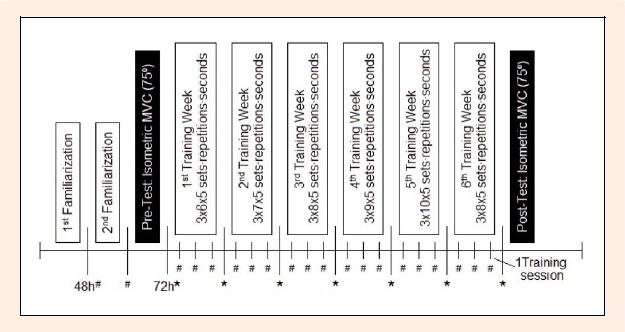
Tests and training protocol timeline. # 48 hours interval. * 72 hours interval.
Procedures MVC Testing
Before tests the subjects completed a 5 min warm-up on a stationary cycle ergometer (Excalibur Sport, Lode B.V., Groningen, Nederland) with 50 W and 70 rpm. Subjects were then accommodated on the dynamometer chair at the upright sitting position with an anterior trunk/thigh angle of 85°. The femoral lateral epicondyle was aligned to the dynamometer axis of rotation. The subjects were also firmly strapped to the dynamometer with two transversal shoulder to hip belts fixing the trunk, one hip belt, and one belt at the distal thigh. The lower leg was fixed to the lever arm of the dynamometer just above the medial malleolus. The angle between the thigh and leg was 75° (0 = full extension). The isometric test consisted of two maximal isometric contractions (knee extension). Isometric contractions lasted 5 seconds, with 30 seconds of rest between each contraction. For both testing and training conditions, subjects were instructed to perform isometric efforts “as fast and as forcefully as possible”, during which strong verbal encouragement was provided by the researchers.
Training
Eighteen training sessions were required, which were distributed throughout 6 weeks (three sessions/week). All training sessions were supervised by one of the researchers, and the adherence to the training program was 100%. The aim of the training programme was to enhance both explosive (high-RFD contraction) and maximal strength (sustained high-load contractions). Thus, subjects were instructed to perform vigorous isometric KE, in an attempt to achieve at least 90% of their MVC as quickly as possible, hold it for 5 s, and relax. Figure 2 confirms that the target force was quickly attained during all training weeks. During the first training week the sets vs. repetitions vs. time (s) under contraction were 3x6x5. From the second to fifth week there was an increase of one repetition per week while the number of set and time under contraction were maintained as in the first week (3x7x5 - 3x8x5 - 3x9x5 - 3x10x5). In the last week, the training was the same as in the third week (3x8x5), so the total volume was reduced aiming to generate a training tapering period. The taper was included in the program because it has been shown to result in significantly higher post-test MVC following resistance strength training program (Gibala et al., 1994). During all the training sessions there was 2 minutes of interval between each set and 15 seconds between repetitions.
Figure 2(A-F).
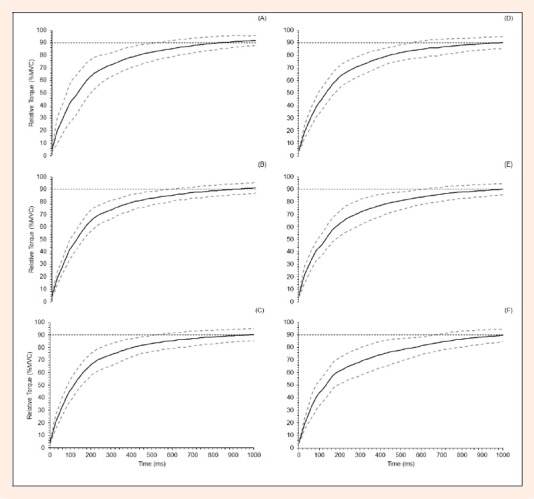
Normalized moment-time curve, averaged for all subjects from the first (A) to sixth (F) week of training. For each subject, data obtained in all repetitions performed during the first weekly training session were collapsed. Dashed horizontal line corresponds to 90% of maximal voluntary contraction (MVC). Data are expressed as mean (solid line) ± SD (dashed line).
Data processing and analyses
The torque data were exported as a text file from the dynamometer and analyzed by using specific algorithms created in MatLab environment (The MathWorks, Natick, MA, USA). Torque curves were smoothed by a digital fourth-order zero-lag Butterworth filter with a cutoff frequency of 20 Hz (Winter, 1990). The contractions with the highest isometric (MVC) torque were chosen for further analysis. RFD was obtained by the isometric contraction slope of the moment-time curve (i.e., ∆moment / ∆time) across time epochs of 0-10, 0-20, …, 0-250 ms relative to the contraction onset and its peak (RFDMAX). The onset of muscle contraction was defined as the time point where the KE torque exceeded the baseline by 2.5% of the baseline-to-peak difference (Andersen et al., 2010). RFD was also normalized (RFDr) by MVC (%MVC·s-1) and calculated at the same time epochs used for RFD and its peak (RFDrMAX).
Statistical analyses
Data are expressed as mean ± SD. Changes in main parameters were analyzed using multivariate analysis of variance with repeated measures. Factors included in model for RFD and RFDr were training period (pre- and post-intervention), group (resistance training and control group) and contraction time (0-10, 0-20, …, 0-250 ms from onset of muscle contraction). Factors included in model for MVC, RFDMAX and RFDrMAX were training period (pre - and post - intervention) and group (resistance training and control group). When appropriate, post hoc comparisons were made with the Tukey test. All statistical analyses were performed using SPSS version 17.0 software (SPSS Inc., Chicago, IL, USA) and the significance level was set at p < 0.05.
Results
MVC
There was a significant main effect of training for MVC (F = 7.43, p = 0.01). Post-hoc test showed a significant increase of MVC (19%) for TG whereas no changes were found for CON (Figure 3).
Figure 3.
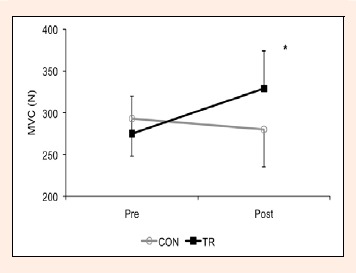
Mean ± SD values of isometric peak torque (MVC) for trained group (TR) and control group (CON) before (Pre) and after (Post) the training period. *p ≤ 0.001 in relation to pre-test.
RFDMAX and RFDrMAX
There was no significant main effect of training for RFDMAX (F = 3.30, p = 0.10) and RFDrMAX (F = 0.17, p = 0.68) (Figure 4).
Figure 4.
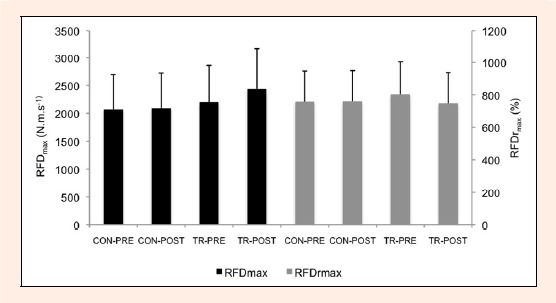
Mean ± SD values of maximum rate of force development (RFDMAX) and maximum relative rate of force development (RFDrMAX) for trained group (TR) and control group (CON) before (Pre) and after (Post) the training period.
RFD and RFDr at different times of contraction (0-10, 0-20, …, 0-250 ms)
Figures 5A to 5D represent RFD and RFDr time curves in different times epochs at pre- and post-training periods. There was a significant main effect of training for RFD (F = 48.32, p < 0.001) whereas no change occurred in RFDr (F = 0.49, p = 0.48). Post-hoc test showed significant increase of RFD at 0-10 ms (28%, p = 0.006) and at 0-20 ms (22%, p = 0.03) for TG whereas no changes were verified for CON.
Figure 5(A-D).
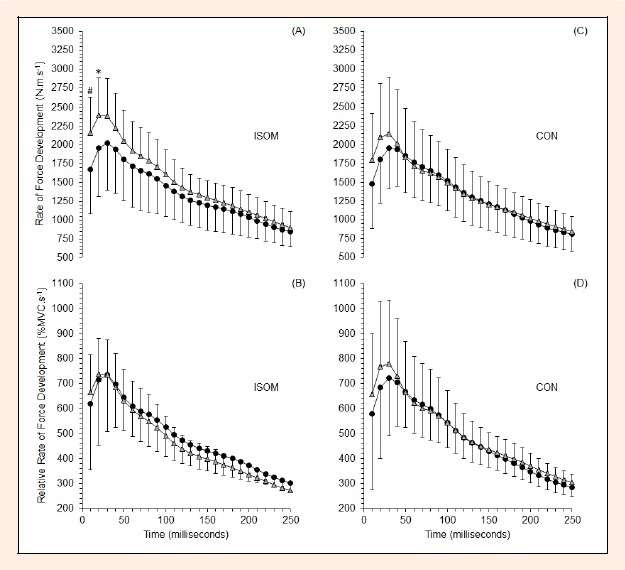
Group mean ± SD values of rate of force development (RFD) and relative rate of force development (RFDr) in different times of contraction rise of isometric training (ISOM) and control (CON) groups obtained at pre- (black circles line) and post- (gray triangles line) training or daily activity periods, respectively. # p < 0.01; * p < 0.05 in relation to pre-test.
Discussion
In this study we have investigated the effects of a 6-week isometric resistance training designed to improve explo-sive and maximal strength on RFD in different time-epochs varying from 10 to 250 ms from the contraction onset. We have demonstrated that RFD at a very early phase (i.e., 0-20 ms) of rising muscle force increased in response to resistance training, whereas, both late RFD and RFDr remained unchanged. Moreover, consistent with previous research (Tillin et al., 2011; 2012) short-term isometric resistance training increased MVC (19%).
The use of resistance training to induce adaptations on RFDMAX has generated different results. These include significant enhancements on RFDMAX (Aagaard et al., 2002; Hakkinen et al., 2003; Kubo et al., 2001) and no changes in this variable in other investigations (Baker et al., 1994; Häkkinen et al., 1998). A direct comparison among studies must be made with caution, since exercise intensity, movement velocity, training duration and fitness status prior to training may be different from study to study. Recent investigations have highlighted the importance of performing contractions with an intended ballistic effort during isometric training focusing on RFD enhancements (Tillin et al., 2011; 2012). Tillin et al., 2012 have found that RDF was enhanced after training with explosive isometric contractions (1 s “fast and hard”), whereas no changes in RFD were found following resistance training focusing on maximum force, rather than explosive actions (Tillin et al., 2011). However, in our study, with similar conditions (i.e. time duration and specificity of the test and training exercises), we have found that RFDMAX remained unchanged after resistance training for explosive and maximal strength. Thus, performing muscle actions with an intended ballistic effort might not be the only underlying mechanism that modulates RFDMAX improvement following isometric strength training.
The different phases of RFD curves can be differently modified by resistance training protocols (Andersen et al., 2010, Blazevich et al., 2008; Oliveira et al., 2013). Andersen et al., 2010 have found that only late RFD was enhanced in response to 14 weeks of high-intensity (i.e., 6-12 RM) resistance training. On the other hand, Blazevich et al., 2008 and Oliveira et al., 2013 foundthat a short period (5 and 6 weeks, respectively) of resistance training (slow- and fast-speed maximal strength training, respectively) improved early RFD, while late RFD remained unchanged. Similarly, we have shown differential changes in early and late RFD in response to 6 weeks of resistance training for explosive and maximal strength. Thus, our data confirm that isometric resistance training performed with an intended ballistic effort can improve very early RFD. In whole, these studies show that the method of analysing RFD influences the interpretation of the effects of resistance training on neuromuscular properties of explosive strength. Moreover, the increase in early RFD found in the present study has important practical implications for explosive sports (Aagaard et al., 2011) and postural balance (Aagaard et al., 2010). The time spans (50 - 250 ms) involved in the explosive type muscle actions may not allow maximal muscle force (i.e, MVC) to be reached. Thus, an augmentation in early RFD allows an increase in the maximal force and velocity that can be achieved during rapid movements (Aagaard et al., 2002).
When normalized to MVC (%MVC·s-1), RFD in the early phase has been found to increase after both explosive-type (Oliveira et al., 2013; Tillin et al., 2012) and heavy resistance training (Aagaard et al., 2002). This change in relative RFD properties appears to have resulted from neural adaptations specific to explosive force production. Accordingly, higher agonist neural drive in the early contraction phase has been found after short-term explosive strength training (Tillin et al., 2012). However, other studies have demonstrated a significant decrease of normalized RFD in the early phase of contraction after both high-intensity (i.e., 6-12 RM) resistance training (Andersen et al., 2010) and isometric resistance training to enhance MVC via sustained (> 2 s) high-load contractions (Tillin et al., 2011). RFD obtained during the early contraction phase is related to the intrinsic contractile properties of the muscle and MVC (Andersen and Aagaard, 2006). Thus, relative RFD can be influenced by cross-bridge cycling rate, which is greatest in fast type IIX muscle fibers. However, resistance training may reduce relative proportion of muscle containing myosin heavy chain IIX (Andersen et al., 2010), even after just 4 weeks of training (Staron et al., 1994). Accordingly, Andersen et al., 2010 have found that changes in early-phase RFDr were positively related (r = 0.61, p < 0.05) to changes in area percentage of type IIX following resistance training. Thus, resistance training designed to enhance MVC via sustained (> 2 s) high-load contractions seems to decrease early RFD via training-induced transition of myosin heavy chain expression from type IIX to IIA.
We have observed in the present study that both early and late RFD remained unchanged after resistance training designed to improve explosive and maximal strength. Therefore, in our experimental conditions, it is possible to speculate that both increased MVC and reduced proportion of muscle containing myosin heavy chain IIX might have induced attenuated increases in early RFD and, therefore RFDr was not influenced by resistance training. Additionally, it is possible that changes in skeletal muscle architecture (e.g., pennation angle - θp) influenced the RFDr after our resistance training program. A large anatomical θp, which allows more sarcomeres to be arranged in parallel, is positively associated with MVC (Cormie et al., 2011). However, smaller anatomical θp, which allows more sarcomeres to be arranged in series, has a positive influence on RFD (Gans and Gaunt, 1991). Accordingly, Seyennes et al., 2007 and Blazevich et al., 2007 documented significant increases in vastus lateralis fascicle angle (7.7 and 11.0%, respectively) following a short period (5 weeks) of resistance training (high-intensity and slow-speed strength training, respectively).
Conclusion
It can be concluded that contractile RFD in the early and later phases of rising muscle force responded differently to a 6-week isometric resistance training for explosive and maximal strength. This training has induced gain in both very early RFD and MVC whereas late RFD and RFDr remained unchanged.
Acknowledgements
We thank the volunteers for participation in this study, Fundação de Amparo a Pesquisa do Estado de São Paulo, Fundação para o Desenvolvimento da Universidade Estadual Paulista and Conselho Nacional de Desenvolvimento Científico e Tecnológico for financial support.
Biographies
Felipe B.D. Oliveira
Employment
Human Performance Laboratory, UNESP
Degree
MSc
Research interests
Exercise physiology, training
E-mail: felps_o@hotmail.com
Anderson S.C. Oliveira
Employment
Human Performance Laboratory, UNESP
Degree
PhD
Research interests
Biomechanics, training and motor learning
E-mail: castelo_emg@hotmail.com
Guilherme F. Rizatto
Employment
Human Performance Laboratory, UNESP
Degree
MSc
Research interests
Exercise physiology, training
E-mail: chivamor@hotmail.com
Benedito S. Denadai
Employment
Human Performance Laboratory, UNESP
Degree
PhD
Research interests
Exercise physiology, training
E-mail: bdenadai@rc.unesp.br
References
- Aagaard P., Simonsen E.B., Andersen J.L., Magnusson P., Dyhre-Poulsen P. (2002) Increased rate of force development and neural drive of human skeletal muscle following resistance training. Journal of Applied Physiology 93(4), 1318-1326 [DOI] [PubMed] [Google Scholar]
- Aagaard P., Suetta C., Caserotti P., Magnusson S.P., Kjaer M. (2010) Role of the nervous system in sarcopenia and muscle atrophy with aging: strength training as a countermeasure. Scandinavian Journal of Medicine and Science in Sports 20(1), 49-64 [DOI] [PubMed] [Google Scholar]
- Aagaard P., Andersen J.L., Bennekou M., Larsson B., Olesen J.L., Crameri R., Magnusson S.P., Kjaer M. (2011) Effects of resistance training on endurance capacity and muscle fiber composition in young top-level cyclists. Scandinavian Journal of Medicine and Science in Sports 21(6), e298-307 [DOI] [PubMed] [Google Scholar]
- Andersen L.L., Aagaard P. (2006) Influence of maximal muscle strength and intrinsic muscle contractile properties on contractile rate of force development. European Journal of Applied Physiology 96(1), 46-52 [DOI] [PubMed] [Google Scholar]
- Andersen L.L., Andersen J.L., Zebis M.K., Aagaard P. (2010) Early and late rate of force development: differential adaptive responses to resistance training? Scandinavian Journal of Medicine and Science in Sports 20(1), 162-169 [DOI] [PubMed] [Google Scholar]
- Baker D., Wilson G., Carlyon B. (1994) Generality versus specificity: a comparison of dynamic and isometric measures of strength and speed-strength. European Journal of Applied Physiology and Occupational Physiology 68(4), 350-355 [DOI] [PubMed] [Google Scholar]
- Blazevich A.J., Cannavan D., Coleman D.R., Horne S. (2007) Influence of concentric and eccentric resistance training on architectural adaptation in human quadriceps muscles. Journal of Applied Physiology 103:1565-1575 [DOI] [PubMed] [Google Scholar]
- Blazevich A.J., Horne S., Cannavan D., Coleman D.R., Aagaard P. (2008) Effect of contraction mode of slow-speed resistance training on the maximum rate of force development in the human quadriceps. Muscle & Nerve 38(3), 1133-1146 [DOI] [PubMed] [Google Scholar]
- Bojsen-Møller J., Magnusson S.P., Rasmussen L.R., Kjaer M., Aagaard P. (2005) Muscle performance during maximal isometric and dynamic contractions is influenced by stiffness of the tendinous structures. Journal of Applied Physiology 99:986-94 [DOI] [PubMed] [Google Scholar]
- Cormie P., McGuigan M.R., Newton R.U. (2011) Developing maximal neuromuscular power: part 1 biological basis of maximal power production. Sports Medicine 41, 17-38 [DOI] [PubMed] [Google Scholar]
- Gans C., Gaunt A.S. (1991) Muscle architecture in relation to function. Journal of Biomechanics 24, 53-65 [DOI] [PubMed] [Google Scholar]
- Geertsen S.S., Lundbye-Jensen J., Nielsen J.B. (2008) Increased central facilitation of antagonist reciprocal inhibition at the onset of dorsiflexion following explosive strength training. Journal of Applied Physiology 105(3), 915-922 [DOI] [PubMed] [Google Scholar]
- Gibala M.J., MacDougall J.D., Sale D.G. (1994) The effects of tapering on strength performance in trained athletes. International Journal of Sports Medicine 15(8), 492-497 [DOI] [PubMed] [Google Scholar]
- Gruber M., Gollhofer A. (2004) Impact of sensorimotor training on the rate of force development and neural activation. European Journal of Applied Physiology 92(1-2), 98-105 [DOI] [PubMed] [Google Scholar]
- Hakkinen K., Alen M., Kraemer W.J., Gorostiaga E., Izquierdo M., Rusko H., Mikkola J., Häkkinen K., Newton R.U., Gordon S.E., McCormick M., Volek J.S., Nindl B.C., Gotshalk L.A., Campbell W.W., Evans W.J., Häkkinen A., Humphries B.J., Kraemer W.J. (1998) Changes in muscle morphology, electromyographic activity, and force production characteristics during progressive strength training in young and older men. Journal of Gerontology: Biological Sciences and the Journal of Gerontology: Medical Sciences 53(6), B415-423 [DOI] [PubMed] [Google Scholar]
- Hakkinen A., Valkeinen H., Kaarakainen E., Romu S., Erola V., Ahtiainen J., Paavolainen L. (2003) Neuromuscular adaptations during concurrent strength and endurance training versus strength training. European Journal of Applied Physiology 89(1), 42-52 [DOI] [PubMed] [Google Scholar]
- Kubo K., Kanehisa H., Ito M., Fukunaga T. (2001) Effects of isometric training on the elasticity of human tendon structures in vivo. Journal of Applied Physiology 991(1), 26-32 [DOI] [PubMed] [Google Scholar]
- Mirkov D.M., Nedeljkovic A., Milanovic S., Jaric S. (2004) Muscle strength testing: evaluation of tests of explosive force production. European Journal of Applied Physiology 91(2-3), 147-154 [DOI] [PubMed] [Google Scholar]
- Oliveira F.B.D., Rizatto G.F., Denadai B.S. (2013) Are early and late rate of force development differently influenced by fast-velocity resistance training?. Clinical Physiology Function Imaging, in press [DOI] [PubMed] [Google Scholar]
- Staron R.S., Karapondo D.L., Kraemer W.J., Fry A.C., Gordon S.E., Falkel J.E., Hagerman F.C., Hikida R.S. (1994) Skeletal muscle adaptations during early phase of heavy-resistance training in men and women. Journal of Applied Physiology 76(3), 1247-1255 [DOI] [PubMed] [Google Scholar]
- Suetta C., Aagaard P., Rosted A., Jakobsen A.K., Duss B., Kjaer M., Magnusson P. (2004) Training-induced changes in muscle CSA, muscle strength, EMG, and rate of force development in elderly subjects after long-term unilateral disuse. Journal of Applied Physiology 97(5), 1954-1961 [DOI] [PubMed] [Google Scholar]
- Seyennes O.R., de Boer M., Narici M.V. (2007) Early skeletal muscle hypertrophy and architectural changes in response to high-intensity resistance training. Journal of Applied Physiology 102, 368-373 [DOI] [PubMed] [Google Scholar]
- Tillin N.A., Pain M.T.G., Folland J.P. (2011) Short-term unilateral resistance training affects the agonist-antagonist but not the force-agonist activation relationship. Muscle & Nerve 43(3), 375-384 [DOI] [PubMed] [Google Scholar]
- Tillin N.A., Pain M.T.G., Folland J.P. (2012) Short-term training for explosive strength causes neural and mechanical adaptations. Experimental Physiology 97(5), 630-641 [DOI] [PubMed] [Google Scholar]
- Winter D.A. (1990) Biomechanics and Motor Control of Human Movement. 2nd edition. Wiley-Interscience, New York [Google Scholar]


